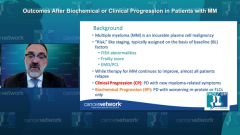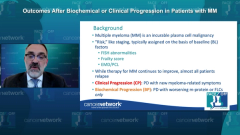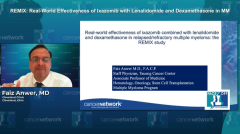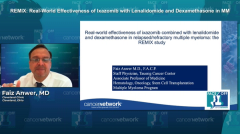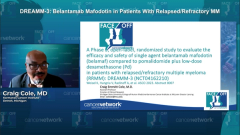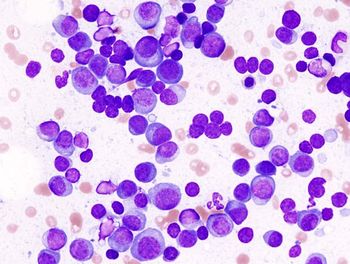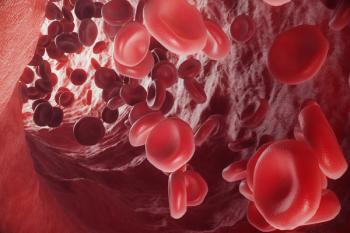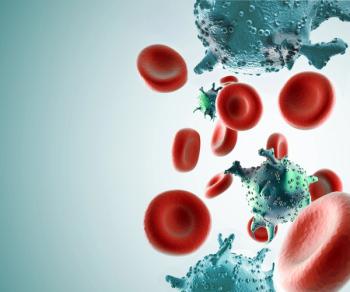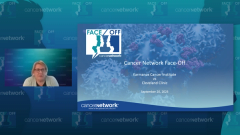
REMIX: Real-World Effectiveness of Ixazomib with Lenalidomide and Dexamethasone in MM
Faiz Answer, MD, FACP, reviews data from the REMIX study on the real-world effectiveness of ixazomib combined with lenalidomide and dexamethasone in relapsed/refractory multiple myeloma.
Episodes in this series

Transcript:
Judy Schreiber, PhD, RN: We’re going to move on to a presentation by Dr Anwer, on ixazomib [Ninlaro], in combination with lenalidomide and dexamethasone in the REMIX-1 study [NCT05030311].
Faiz Anwer, MD, FACP: This is the real-world effectiveness of a 3-drug combination using ixazomib, with Revlimid [lenalidomide] and dexamethasone [IXA-Rd] for relapsed/refractory multiple myeloma [RRMM] in the REMIX-1 study.
The REMIX-1 study is one of the largest prospective real-world analyses of the effectiveness of the IXA-Rd combination in a setting of RRMM. The study was conducted in France between August 2017 and October 2019. It was a noninterventional, prospective, observational study. The sample size was 376 patients, and the regimen they received was not uniform; the dose was the physician’s choice.
There were some minor changes or differences in the dose of ixazomib. Some patients got 4 mg and some patients got 3 mg. Similarly, Revlimid was given at different dosages, including 25 mg, 20 mg, and 15 mg. This regimen was used in second-line and third-line settings as well as later lines of therapy. These patients were followed for at least 24 months.
The primary end point of the study was to look at the median progression-free survival [PFS], and the secondary end points were the overall survival and duration of response. Responses were assessed based on the standard criteria for CR [complete response], VGPR [very good partial response], partial responses [PR], and stable disease. The overall response is the objective responsive rate combined with CR, VGPR, and PRs. They also looked at the safety end points and adverse effects.
The median age of the study’s population was 71 years old. About one-fifth of the patients were older. So it was an all-order regimen for those frail patients.
These patients we talked about had had prior lines of therapy. About 60% of patients on this regimen were using it as a second line, and about 20% of patients were using this therapy in the third, fourth, or after the fourth line of therapy.
The median PFS for the entire cohort was about 19 months. The objective response rate was about 73% in these patients, depending on if this therapy was used as a second- or third-line therapy, where the PFS was about 21 months. If the therapy was used fourth line, and after that, then there was a significant drop in the median PFS, which makes perfect sense. This is an oral regimen using an immunomodulatory drug and a PI [proteasome inhibitor], and by the time patients are on the fourth line of therapy, they are likely penta-refractory and they are refracted to immunomodulatory drugs and proteasome inhibitors.
The observation to note here was that IXA-Rd, when used in the second- or third-line setting, had a median PFS very similar to patients who were previously exposed to lenalidomide and patients who were not exposed to lenalidomide.
So this is the schema of the PFS graphs. And we can see that there was no clear difference if you compare the PFS in the second and third lines of therapy with the fourth line or higher therapy where there’s a significant difference in the PFS in that setting.
Although adverse events were reported by the majority of the patients, treatment-related adverse effects were only seen in about 40% of the patient population. And the discontinuation rate of IXA [ixazomib] was only about 20%.
Now the results from this cohort were compared with the phase 3 TOURMALINE-MM1 study [NCT01564537], which was a double-blind phase 3 study on RRMM.It was 3 drugs vs 3 drug arms. Efficacy wise, in the REMIX-1 study, the PFS was about 19 months and the objective responses were about 73%, and that’s very comparable to the median PFS of 20 months in the phase 3 study, as well as the objective responses, which were also comparable.
Of course, this is not a comparison, but it’s good to know that the efficacy was not different in the real-world setting when you’re not tightly controlling all the parameters. You’re not controlling and dictating the dosages, which are used in real-world scenarios.
Though the patients in the REMIX-1 study were older, they likely had more advanced disease and multiple prior lines of therapy. Their performance status was actually worse compared with the phase 3 study, and they have a higher number of patients who are not Len [lenalidomide] naïve, and even in that setting, the efficacy was not much different.
So looking at this data, I think we are comfortable in concluding that the REMIX-1 study results are consistent with the results of the TOURMALINE-MM1 study [results], and it confirms the benefit of the IXA-Rd combination in real life and for these [older] patients. It’s a convenient oral regimen, without compromising the efficacy.
This is a good option for patients in the second and third line of therapy. And it shows the efficacy in the older, frail, patient population with an acceptable toxicity profile. Thank you.
Transcript is AI-generated and edited for clarity and readability.
Newsletter
Stay up to date on recent advances in the multidisciplinary approach to cancer.




